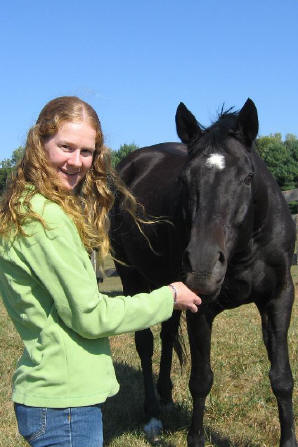Pets Large & Small
Communicators and Hair Dye
Dr. Kim Brokaw, DVM
|

Dr. Kim Brokaw and her horse Bart |
(May, 2010) It was Easter weekend and, as usual, I was spending it in a less-than-traditional manner. Saturday morning, I had woken up early for an embryo transfer on a mare, and then drove back to Virginia for dinner with the family. My mom, who is a human nurse, was working Easter Sunday, so the
family usually celebrated holidays the day before. Because if she wasn't working, then I probably was. I drove back to the clinic Sunday morning because I was meeting up with one of my friends. She is a small animal vet and made a declaration in vet school to never work on anything weighing over 200 pounds. While the weather
on Sunday was delightful, it was supposed to get very hot in the next few days. My one horse, Herbie, is a large grey draught cross with PPID (Cushing's Disease.) Because of his hormone imbalance, he grows an excessive amount of hair and needed to be clipped for summer. We figured that while we were clipping him, we could also
give him a bath and, as it was Easter, dye him bright colors. My friend pointed out that they do make animal hair dye, but as we had not planned ahead, we didn't have any.
Food coloring seemed like a logical choice, but, as it was Easter, Safeway was out of it. Grape and Cherry flavored Kool-aide seemed like an appropriate alternative. Herbie was very patient and tolerated the dyeing process well, but the color only lasted about 36 hours. Selecting dye for Herbie reminded
me of a pony who had a reaction to dye and scratched out her hair. The pony's experience made me reluctant to use human hair dye on Herbie. Like people, horses can have hypersensitivity reactions to hair dye.
Lady Jane was a very cute Welsh pony. She was the favorite ride of a few young children, as she was always in the ribbons at the hunter shows. She had been competing successfully for about four years when Jane stopped jumping. At first the owners treated her at home by giving her a few days off and some
bute (the horse equivalent of aspirin). When they started riding Jane again, she jumped for the first couple days and then quit again. Lady Jane's owners knew that there was something wrong with their pony, since she had always been a very cooperative and skilled jumper. They knew they needed some assistance for their pony, so
they called an equine communicator. The communicator "talked" with the pony over the phone and told the owners that the reason Jane wasn't jumping anymore was because she was depressed because no one had ever thrown her a birthday party and that her favorite color was pink.
The family decided to throw a party that would be the envy of any 9-year-old girl. Pink ribbons and balloons were placed all throughout the barn with Disney princess-themed table cloth and plates, and they even had carrot cake. And to top it all off, they decided to dye Lady Jane pink. This would have
been a lovely party and I am sure that pony probably would have enjoyed it, except that she had a reaction to the dye and started scratching out all of her hair. So now, the pretty bay mare is pink with bald patches.
The owners quickly put in a panicky call to their herbalist and told him what was going on. The herbalist gave them some good advice, such as washing off the dye and giving the pony an oatmeal bath shampoo. After the bath she instructed them to get marshmallow extract and put some of that on the skin.
This got misinterpreted and the pony had Marshmallow Fluff applied to her. As it was, washing off the dye was enough to stop the itching and Jane was already starting to grown back her mane and tail when I got involved in the case. The birthday party hadn't been enough to get Jane jumping again. A lameness exam was performed
and it was determined that she had some mild hock arthritis. A few joint injections and Lady Jane was back to jumping happily. In the end, time, and the end of allergy season, was what ended the pony's itchiness.
One of the more frustrating things about being a veterinarian is that clients are getting more and more medical information from trainers, herbalists, the internet, the person at the feed store, and some random person they met at the gas station wearing riding clothes. Don't get me wrong, a lot of good
information can be learned from these horse people. When a client says that there horse refuses to jump ditches or won't load in a trailer, I tell them to find a good horse trainer. But, like everything in life, having the right tool is essential for solving the problem. If the heat goes out in your house, don't call the
veterinarian. I won't be able to help you. So, when your horse starts running a fever, please don't call a plumber.
Editor's Note: Kim Brokaw applies her talents and love of animals at the Walkersville Veterinary Clinic.
Read other articles by Dr. Kim Brokaw